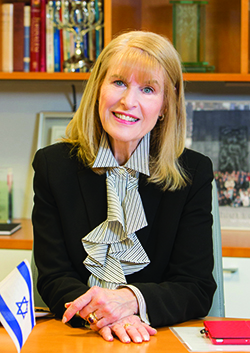Hadassah
President's Column
Footprints in the Sand

The Hebrew calendar is full of holidays this time of year: Israel’s Holocaust Remembrance Day (Yom Hashoah), Memorial Day (Yom Hazikaron) and Independence Day (Yom Ha’atzmaut), all in May; and Jerusalem Day (Yom Yerushalayim) and Shavuot in June.
Some people may wonder why Israel’s national holidays appear on the calendar used by Jews around the world.
Since Israel emerged as a state only in 1948, the question’s underlying assumption is that connecting the Jewish people to the Jewish state is something new. But given our history, the question ought to be: Why not?
The explanation is in the Bible, the siddur and over 2,000 years of tradition, during which Jews everywhere linked their everyday lives to the Land of Israel. Pesach, Shavuot and Sukkot are the three pilgrimage festivals when our forebears went to the Temple in Jerusalem. Shavuot and Sukkot, whether observed by Jews in Alaska, Algeria or Australia, are tied to Israel’s agricultural cycle. In the Amidah prayer, the text changes—regardless of latitude—according to Israel’s rainy and dry seasons.
So, the idea of enshrining modern Israel’s commemorations on the universal Jewish calendar is consistent with the entire sweep of our history. You can criticize the conduct or policy of Israel’s leaders (just look at an Israeli newspaper on any day), but you can’t separate the Jewish people from Israel. You don’t have to be a Jew to be a Zionist, but Zionism—the belief and support of Israel’s centrality in Jewish existence—grows out of Jewish practice and education.
Israel’s modern rebirth represented not the opening of a new frontier but the closing of a circle. And most Jews I know have a palpable sense of coming full circle every time they arrive in the Jewish state, even if only for a brief visit. It’s as if they are fulfilling the injunction of pilgrimage.
Today, Hadassah, which has played a role in Israel’s rebirth, sits at the table in world Zionist forums and in Israel. We are the only organization with the word “Zionist” in its title to achieve nongovernmental organization, or NGO, status at the United Nations and our name is a household word, synonymous with excellence in health care in the Jewish state.
And we’re looking to restore a key element of our profile.
When our Ein Kerem hospital campus was dedicated in 1960, with our iconic Round Building as its anchor, it closed both a void and a circle. We lost our hospital on Mount Scopus in 1948 when it was cut off behind Jordanian lines by the cease-fire that ended Israel’s War of Independence. For more than a decade, we operated out of a network of small buildings in central Jerusalem before the Ein Kerem campus was built.
The Round Building at Ein Kerem was part of a new wave in hospital architecture, its walkways curving around a central core designed to eliminate the long, impersonal corridors of traditional medical centers. It was state of the art and served us well for more than 50 years.
Dedicating the 19-story Sarah Wetsman Davidson Hospital Tower in 2012 was another leap into the future. But seven years later, the tower, which is adjacent to the Round Building and still a cutting-edge exemplar of medical care, is above 100 percent capacity. And looking to the story of rebuilding our own land instead of looking for a new one, we have a ready solution.
The Round Building, emptied by the move into the tower, is ready for renovation. We’ve launched a $91-million effort—called 360º of Healing: The Full Circle Campaign—to bring it into the 21st century. Call it our restate-of-the-art facility. Visit hadassah.org/360degrees to see how you can get involved.
Building Israel’s health care infrastructure, educating at-risk children through Youth Aliyah and refreshing Zionism through scholarships for Young Judaeans are Hadassah’s ways of jumping off the pages of Jewish texts and making a mark in the Jewish homeland. Observe the calendar close enough and you’ll see our footprints.










 Facebook
Facebook Instagram
Instagram Twitter
Twitter
Leave a Reply